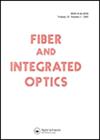光纤连接器对QKD传输的影响
IF 2.2
4区 物理与天体物理
Q2 OPTICS
引用次数: 0
摘要
摘要本文研究了不同光连接器抛光技术对量子密钥分配(QKD) Clavis3系统量子信道的影响。首先,简要介绍了这些类型的连接器抛光的基本区别。其次,本文重点设计了一种简单的光路来测量APC/UPC(角度物理接触/超物理接触)连接器对量子通道功能的影响,这归因于两种类型连接器的特性略有不同。然而,这两种类型的连接器通常在实际网络中使用。因此,进行了两个系列的测量,一个用于APC连接器的测量,一个用于UPC连接器的测量。在每个系列中,连接器的数量逐渐增加,对于给定类型,每条路由最多增加12个连接器。最后,给出了测量结果,主要包括三个主要参数的变化。重点监测了密钥率、干涉可见性和量子误码率。关键词:APC/UPC连接器衰减cowidqkey rate qberqkrefectionand visibility披露声明作者未报告潜在的利益冲突。经费这项工作得到了捷克共和国内政部的支持。关于捐款的说明。KlíčníkOndrej Klicnik于1998年出生于布尔诺(捷克共和国)。目前,他是布尔诺理工大学电气工程与通信学院信息安全领域的博士生。在他的学士和硕士论文中,他的研究方向是光网络安全,特别是量子密钥分配。1984年,彼得·明斯特(peter Munster)出生在捷克的兹林。2014年获布尔诺理工大学电信系博士学位,论文题目为FTTx网络参数。目前主要研究方向为光纤传感器,特别是分布式光纤传感器和光纤通信。在过去的五年中,他在期刊和会议上发表了大约50篇科学论文。HorváthTomas霍瓦特1989年出生于捷克共和国的哈维罗夫。他是布尔诺理工大学的年轻研究员,也是CESNET的研究员。他于2017年获得布尔诺理工大学通信与信息学博士学位。他的记录显示了40多篇同行评议的会议记录和期刊论文。他目前的研究兴趣包括光网络、无源光网络和传感。本文章由计算机程序翻译,如有差异,请以英文原文为准。
Impact of Optical Connectors on QKD Transmission
ABSTRACTThis paper describes the effect of different optical connector polishing techniques on the quantum channel of a quantum key distribution (QKD) Clavis3 system. First, the basic differences among these types of connector polishing are briefly described. Second, the paper focuses on the design of a simple optical route to measure the effect of APC/UPC (angled physical contact/ultra physical contact) connectors on the quantum channel functionality, which is attributed to the slightly different characteristics of the two types of connectors. However, both types of connectors are commonly employed in real networks. For this reason, two series of measurements are made, one measurement for APC connectors and one measurement for UPC connectors. In each series, the number of connectors is gradually increased by up to 12 connectors per route for a given type. Finally, the results of the measurements, which mainly comprise changes in the three main parameters, are presented. In particular, the key rate, interferometric visibility and QBER (quantum bit error rate) were monitored.KEYWORDS: APC/UPC connectorsAttenuationCOWIDQKey rateQBERQKDReflectionand visibility Disclosure statementNo potential conflict of interest was reported by the author(s).Additional informationFundingThis work was supported by the Ministry of the interior of the Czech Republic.Notes on contributorsO. KlíčníkOndrej Klicnik was born in Brno (Czech Republic), in 1998. Currently he is a doctoral student in the field of Information Security at the Faculty of Electrical Engineering and Communication at Brno University of Technology. In his bachelor and master thesis he was conducting research in the field of security of optical networks, especially quantum key distribution.P. MünsterPetr Munster was born in 1984, in Zlin (Czech Republic). He received his PhD at the Brno University of Technology, Department of Telecommunications in 2014 on the thesis entitled Parameters of the FTTx networks. His current research themes focus on fiber-optic sensors, especially distributed fiber-optic sensors, and on fiber-optic telecommunications. He has had approximately 50 scientific publications in journals and conferences in the last 5 years.T. HorváthTomas Horvath was born in Havirov, Czech Republic in 1989. He is a young researcher at Brno University of Technology and a researcher at CESNET. He received his PhD degree in communications and informatics from Brno University of Technology in 2017. His record shows more than 40 peer reviewed proceedings and journal papers. His current research interests include optical networking, passive optical networks, and sensing.
求助全文
通过发布文献求助,成功后即可免费获取论文全文。
去求助
来源期刊
CiteScore
3.40
自引率
0.00%
发文量
4
审稿时长
>12 weeks
期刊介绍:
Fiber and Integrated Optics , now incorporating the International Journal of Optoelectronics, is an international bimonthly journal that disseminates significant developments and in-depth surveys in the fields of fiber and integrated optics. The journal is unique in bridging the major disciplines relevant to optical fibers and electro-optical devices. This results in a balanced presentation of basic research, systems applications, and economics. For more than a decade, Fiber and Integrated Optics has been a valuable forum for scientists, engineers, manufacturers, and the business community to exchange and discuss techno-economic advances in the field.

 求助内容:
求助内容: 应助结果提醒方式:
应助结果提醒方式:


